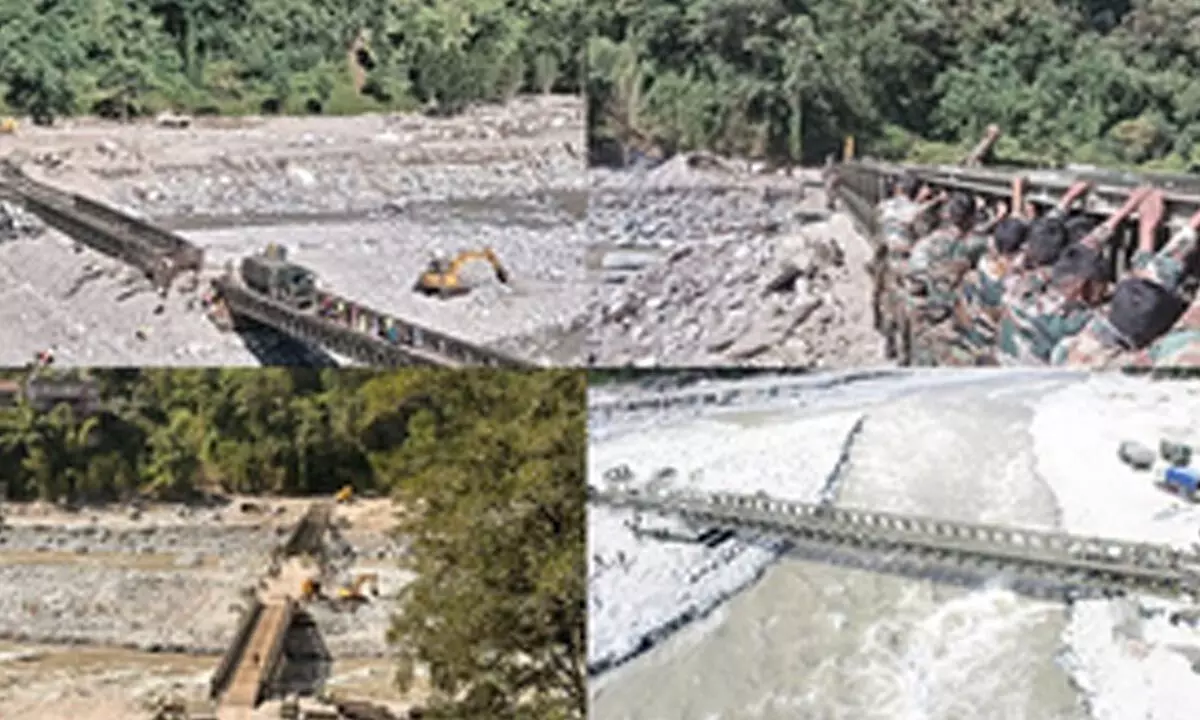Bridge components from GRSE in Kolkata restore connectivity in flood-hit Sikkim
Share :

Components of Bailey Bridges supplied by Garden Reach Shipbuilders and Engineers (GRSE) Ltd -- a premier defence shipyard based in Kolkata -- have helped restore road connectivity in Sikkim that was devastated by floods after eruption of the South Lhonak Lake in the first week of October.
Kolkata: Components of Bailey Bridges supplied by Garden Reach Shipbuilders and Engineers (GRSE) Ltd -- a premier defence shipyard based in Kolkata -- have helped restore road connectivity in Sikkim that was devastated by floods after eruption of the South Lhonak Lake in the first week of October.
Sikkim shares a long border with the Tibet Autonomous Region (TAR) of China and restoration of road connectivity in the state was of great strategic importance for India to maintain a steady supply of men and equipment to forward areas.
Highly-placed sources in GRSE confirmed that the company had supplied components for modular bridges to the Border Roads Organisation (BRO) and the Army and these were used to span Teesta river at locations where bridges were washed away due to the sudden gust of water from the mountains in the north.
For nearly a fortnight now, the Army and BRO, along with the civil administration in Sikkim had been toiling to reconnect North Sikkim to the rest of the country.
While the BRO worked on the main Mangan-Tung-Chungthang route, Army and BRO teams also made efforts to open up the alternate Mangan-Sanklang–Theng-Chungthang one.
This required the construction of two Bailey Bridges across the Teesta at the Mangan-Sanklang Crossing. The first of these bridges were completed on October 22 after round-the-clock work.
"Areas of North Sikkim beyond Mangan remained cut off since October 4. As an immediate response, foot bridges and zip lines were constructed at Chungthang and the Sanklang-Mangan Crossing. These enabled movement of people on foot and provision of transfer of relief material through the zip lines was established. Due to large scale damage to the main Mangan-Tung-Chungthang Road, fresh alignment through Naga Village is being made before the damaged bridge site at Toong can be approached and a new bridge constructed. This will take time," an Eastern Command official said.
"Restoration of connectivity up to Chungthang via alternate Mangan- Sanklang-Theng-Chungthang route was crucial and troops of the Trishakti Corps undertook construction of the Bailey Bridges at the Mangan-Sanklang Crossing, 200 metres upstream of where a bamboo bridge and Zip line had been constructed earlier.
"However, the width of the river at this point has increased to 600-feet and water is running along two channels with a 160-feet-wide island in between. Hence, it was decided to construct two separate bridges. The Army finished construction of the first 150-feet-long and then moved to the second," he added.
The Trishakti Sappers completed the second bridge ahead of schedule on October 26. This has enabled the movement of vehicles carrying relief material to the flood-affected areas
Both bridges were inaugurated by Pintso Lepcha, MLA of DZONGU, North Sikkim, in the presence of officials of the Army, BRO and civil administration.
The Army maintains that engineer troops of the Trishakti Corps along with several heavy Earth Moving plants were employed for this massive two bridge operation, which is a very rare construction.














